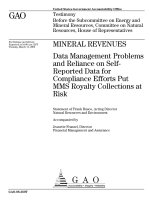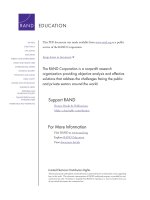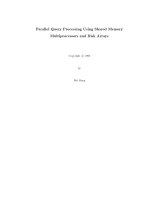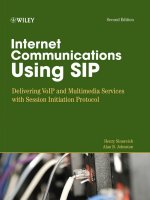Left ventricle segmentation using data driven priors and temporal correlations
Bạn đang xem bản rút gọn của tài liệu. Xem và tải ngay bản đầy đủ của tài liệu tại đây (6.48 MB, 103 trang )
NATIONAL UNIVERSITY OF SINGAPORE
Left Ventricle Segmentation Using
Data-driven Priors and
Temporal Correlations
by
Jia Xiao
A thesis submitted in partial fulfillment for
the degree of Masters of Engineering
in the
Faculty of Engineering
Department of Electrical and Computer Engineering
December 2010
Abstract
Cardiac MRI has been widely used in the study of heart diseases and transplant
rejections using small animal models. However, due to low image quality, quantitative analysis of the MRI data has to be performed through tedious manual
segmentation. In this thesis, a novel approach based on data-driven priors and
temporal correlations is proposed for the segmentation of left ventricle myocardium
in cardiac MR images of native and transplanted rat hearts. To incorporate datadriven constraints into the segmentation, probabilistic maps generated based on
prominent image features, i.e., corner points and scale-invariant edges, are used
as priors for endocardium and epicardium segmentation, respectively. Non-rigid
registration is performed to obtain the deformation fields, which are then used to
compute the averaged probabilistic priors and feature spaces. Integrating datadriven priors and temporal correlations with intensity, texture, and edge information, a level set formulation is adopted for segmentation. The proposed algorithm
was applied to 3D+t cardiac MR images from eight rat studies. Left ventricle endocardium and epicardium segmentation results obtained by the proposed method
respectively achieve 87.1 ± 2.61% and 87.79 ± 3.51% average area similarity and
83.16 ± 8.14% and 91.19 ± 2.78% average shape similarity with respect to manual
segmentations done by experts. With minimal user input, myocardium contours
obtained by the proposed method exhibit excellent agreement with the gold stanii
dard and good temporal consistency. More importantly, it avoids inter- and intraobserver variations and makes accurate quantitative analysis of low-quality cardiac
MR images possible.
iii
Acknowledgements
This thesis would not have been successfully completed without the kind assistance
and help of the following individuals.
First and foremost, I would like to express my deepest appreciation to my supervisors Associate Professor Ashraf Kassim and Assistant Professor Sun Ying for their
unwavering guidance and support throughout the course of this research. I am
grateful for their continual encouragement and advice that have made this project
possible.
I would like to thank Dr. Yi-Jen L. Wu, the researcher from Pittsburgh NMR
Center for Biomedical Research, USA, for her help and effort in providing the
manual segmentation ground truth.
I would also like to thank Mr. Francis Hoon, the Laboratory Technologist of the
Vision and Image Processing Laboratory, for his technical support and assistance.
Last but not least, I would like to extend my gratitude to my fellow lab mates for
their help and enlightenment.
iv
Contents
Abstract
ii
Acknowledgements
iv
List of Publications
ix
List of Tables
x
List of Figures
xi
1 Introduction
1
1.1
Problem Statement . . . . . . . . . . . . . . . . . . . . . . . . . . .
1
1.2
Contributions . . . . . . . . . . . . . . . . . . . . . . . . . . . . . .
3
1.3
Thesis Organization . . . . . . . . . . . . . . . . . . . . . . . . . . .
4
v
2 Background and Previous Work
2.1
2.2
2.3
5
Segmentation . . . . . . . . . . . . . . . . . . . . . . . . . . . . . .
5
2.1.1
Deformable Models . . . . . . . . . . . . . . . . . . . . . . .
6
2.1.1.1
Parametric Active Contours . . . . . . . . . . . . .
7
2.1.1.2
Geometric Active Contours . . . . . . . . . . . . .
10
2.1.2
Texture Segmentation . . . . . . . . . . . . . . . . . . . . .
16
2.1.3
Incorporating Priors . . . . . . . . . . . . . . . . . . . . . .
20
Registration . . . . . . . . . . . . . . . . . . . . . . . . . . . . . . .
22
2.2.1
B-spline Based Free Form Deformation . . . . . . . . . . . .
24
Joint Registration & Segmentation . . . . . . . . . . . . . . . . . .
27
3 Proposed Method
29
3.1
The Cine MRI . . . . . . . . . . . . . . . . . . . . . . . . . . . . . .
29
3.2
Slice-by-slice Segmentation . . . . . . . . . . . . . . . . . . . . . . .
32
3.3
Algorithm Overview . . . . . . . . . . . . . . . . . . . . . . . . . .
36
3.4
Preprocessing . . . . . . . . . . . . . . . . . . . . . . . . . . . . . .
38
3.5
Diffused Structure Tensor Space . . . . . . . . . . . . . . . . . . . .
39
vi
3.6
3.7
3.8
Acquisition of Data-driven Priors . . . . . . . . . . . . . . . . . . .
41
3.6.1
Registration . . . . . . . . . . . . . . . . . . . . . . . . . . .
42
3.6.2
Priors for Endocardium
. . . . . . . . . . . . . . . . . . . .
44
3.6.3
Priors for Epicardium
. . . . . . . . . . . . . . . . . . . . .
46
Establishment of Temporal Correlations . . . . . . . . . . . . . . .
48
3.7.1
Registration . . . . . . . . . . . . . . . . . . . . . . . . . . .
49
3.7.1.1
Endocardium . . . . . . . . . . . . . . . . . . . . .
51
3.7.1.2
Epicardium . . . . . . . . . . . . . . . . . . . . . .
54
3.7.2
Combined Feature Spaces . . . . . . . . . . . . . . . . . . .
55
3.7.3
Combined Probabilistic Prior Maps . . . . . . . . . . . . . .
57
Energy Formulation . . . . . . . . . . . . . . . . . . . . . . . . . . .
60
3.8.1
Endocardium Segmentation . . . . . . . . . . . . . . . . . .
61
3.8.2
Epicardium Segmentation . . . . . . . . . . . . . . . . . . .
62
4 Results & Discussion
4.1
63
Material . . . . . . . . . . . . . . . . . . . . . . . . . . . . . . . . .
63
4.1.1
63
Study Population . . . . . . . . . . . . . . . . . . . . . . . .
vii
4.2
4.3
4.4
4.1.2
Transplantation Model . . . . . . . . . . . . . . . . . . . . .
64
4.1.3
Image Acquisition . . . . . . . . . . . . . . . . . . . . . . . .
64
4.1.4
The Gold Standard . . . . . . . . . . . . . . . . . . . . . . .
65
Qualitative Analysis . . . . . . . . . . . . . . . . . . . . . . . . . .
65
4.2.1
Agreement With Image Features
. . . . . . . . . . . . . . .
65
4.2.2
Temporal Consistency . . . . . . . . . . . . . . . . . . . . .
68
Quantitative Analysis . . . . . . . . . . . . . . . . . . . . . . . . . .
70
4.3.1
Area Similarity . . . . . . . . . . . . . . . . . . . . . . . . .
71
4.3.2
Shape Similarity . . . . . . . . . . . . . . . . . . . . . . . .
72
Discussion . . . . . . . . . . . . . . . . . . . . . . . . . . . . . . . .
75
5 Conclusion & Future Work
79
5.1
Conclusion . . . . . . . . . . . . . . . . . . . . . . . . . . . . . . . .
79
5.2
Future Work . . . . . . . . . . . . . . . . . . . . . . . . . . . . . . .
82
Bibliography
83
viii
List of Publications
Xiao Jia, Chao Li, Ying Sun, Ashraf A. Kassim, Yijen L. Wu, T. Kevin Hitchens,
and Chien Ho, “A Data-driven Approach to Prior Extraction for Segmentation of
Left Ventricle in Cardiac MR Images”, IEEE International Symposium on Biomedical Imaging(ISBI)’09, Boston, USA, June 2009.
Chao Li, Xiao Jia, and Ying Sun, “Improved Semi-automated Segmentation of
Cardiac CT and MR Images”, IEEE ISBI’09, Boston, USA, June 2009.
Xiao Jia, Ying Sun, Ashraf A. Kassim, Yijen L. Wu, T. Kevin Hitchens, and
Chien Ho, “Left Ventricle Segmentation in Cardiac MRI Using Data-driven Priors
and Temporal Correlations” [abstract], 13th Annual Society for Cardiovascular
Magnetic Resonance (SCMR) Scientific Sessions, Phoenix, USA, January, 2010.
ix
List of Tables
4.1
Area similarity . . . . . . . . . . . . . . . . . . . . . . . . . . . . .
70
4.2
Shape similarity . . . . . . . . . . . . . . . . . . . . . . . . . . . . .
76
x
List of Figures
2.1
Evolution of level set function . . . . . . . . . . . . . . . . . . . . .
2.2
Feature channels (u1 , . . . , u4 ) obtained by smoothing I, Ix2 , Iy2 , Ix Iy
13
from left to right and top to bottom. . . . . . . . . . . . . . . . . .
18
2.3
Texture segmentation results . . . . . . . . . . . . . . . . . . . . . .
19
3.1
Illustration of MRI acquisition . . . . . . . . . . . . . . . . . . . . .
30
3.2
Illustration of MRI data of native hearts . . . . . . . . . . . . . . .
31
3.3
Illustration of MRI data of transplanted hearts . . . . . . . . . . . .
32
3.4
Cine imaging for native and heterotopic transplanted hearts . . . .
33
3.5
Illustration of segmentation ambiguity caused by the lack of prominent image feature . . . . . . . . . . . . . . . . . . . . . . . . . . .
xi
34
3.6
Steps of the acquisition of data-driven priors and the establishment
of temporal correlations . . . . . . . . . . . . . . . . . . . . . . . .
3.7
36
Preprocessing. First row: original images. Second row: images after
contrast enhancement. Third row: images after contrast enhancement and inhomogeneity correction. . . . . . . . . . . . . . . . . . .
38
3.8
Diffused structure tensor space of a native rat heart . . . . . . . . .
40
3.9
Diffused structure tensor space of a transplanted rat heart . . . . .
41
3.10 Illustration of registration accuracy along epicardium (native rat
heart). First row: original images. Second row: registered images. .
43
3.11 Illustration of registration accuracy along epicardium (transplanted
rat heart). First row: original images. Second row: registered images. 43
3.12 Extraction of endocardium prior. (a) User provided point; (b) All
corner points detected; (c) Corner points within the LV cavity; (d)
Relative probability density map; (e) Prior map for endocardium
segmentation; (f) Distribution of corner points in polar coordinates.
xii
45
3.13 Extraction of epicardium prior. (a) Original image. (b) Edges detected from the current image. (c) Edges in the current frame after
filtering. (d) Edges detected from all image in the slice. (e) All edges
in the slice after filtering. (f) User provided point. (g) Illustration
2
2
of N (µi,θ , σi,θ
). (h) Illustration of N (µij,θ , σij,θ
). (i) Prior map for
epicardium segmentation. (j) Estimated initial epicardium boundary. 48
3.14 Feature maps for MR images of native and transplanted rat hearts.(a)
Estimated initial epicardium boundary. (b) Ring shape mask. (c)(e) Feature channels u1 , u2 , and u3 . (f) Feature map. . . . . . . . .
52
3.15 More feature maps. First row: original images. Second row: corresponding feature maps. . . . . . . . . . . . . . . . . . . . . . . . . .
52
3.16 Registration Masks. (a,d) Original image. (b,e) Estimated initial
epicardium boundary plotted on the feature map. (c,f) Registration
mask. . . . . . . . . . . . . . . . . . . . . . . . . . . . . . . . . . .
53
3.17 Registration results for endocardium segmentation . . . . . . . . . .
54
3.18 Registration results for epicardium segmentation . . . . . . . . . . .
56
xiii
3.19 Combination of feature spaces (native rat heart). First four columns:
feature space of individual frames. Fifth column: combined feature
space for endocardium segmentation. Last column: combined feature space for epicardium segmentation. . . . . . . . . . . . . . . .
57
3.20 Combination of feature spaces (transplanted rat heart). First four
columns: feature space of individual frames. Fifth column: combined feature space for endocardium segmentation. Last column:
combined feature space for epicardium segmentation. . . . . . . . .
58
3.21 Combination of prior maps. First four columns: prior maps of individual frames. Fifth column: combined prior maps. Last column:
corresponding original images. . . . . . . . . . . . . . . . . . . . . .
59
4.1
Agreement with image features of segmentation results . . . . . . .
66
4.2
Comparison of temporal consistency of segmentation results . . . .
68
4.3
Area Similarity . . . . . . . . . . . . . . . . . . . . . . . . . . . . .
71
4.4
Flowchart for calculating shape similarity measure . . . . . . . . . .
74
4.5
Shape Similarity
77
. . . . . . . . . . . . . . . . . . . . . . . . . . . .
xiv
Chapter 1
Introduction
1.1
Problem Statement
Small rodent animal models are widely used in evaluating pharmacological and
surgical therapies for cardiovascular diseases. With the help of noninvasive imaging
tools, like cardiac magnetic resonance imaging (MRI), in-vivo quantitative analysis
of heart function of small animal models becomes possible in cardiac pathological
studies and therapy evaluations [1, 2].
Reliable quantitative analysis of cardiac MRI data requires accurate segmentation
of the left ventricle (LV) myocardium, which is tedious and time-consuming when
performed manually. In addition to its high labor cost, manual segmentation
also suffers from inter- and intra-observer variations. Therefore, it is desirable to
1
design an automated segmentation system which produces accurate and consistent
segmentation results.
Automated segmentation of small animal MRI data is very challenging, and existing algorithms lack accuracy as well as robustness in solving such segmentation
problems. Different from human hearts, rat hearts are small in size, therefore cardiac MR images acquired from rats normally have very limited spatial resolution
and low signal-to-noise ratio (SNR). In allograft rejection studies [2], the transplanted rat heart is placed in recipient’s abdomen and edges are not as well defined
as is found when the native heart is surrounded by the lung. Moreover, turbulent
blood flow often causes confusing edges in the LV cavity.
Although many approaches have been reported for the automated segmentation
of human hearts [3], few methods have been proposed to segment small animal
hearts. The STACS method proposed in [4] has been shown to produce relatively
accurate segmentation results on short-axis cardiac MR images of a rat by combining region-based and edge-based information with an elliptical shape prior and
contour smoothness constraint. Proposed in [5], a deformable elastic template has
been utilized to segment left and right ventricles of mouse heart simultaneously in
3D cine MR images.
The above mentioned methods achieved acceptable segmentation in MR images
of native rat heart, but they perform poorly on MRI data used in the study of
2
animal heart transplantation. To realize accurate automatic segmentation of the
LV myocardium in MR images of both native and transplanted rat hearts, new
approaches have to be explored.
1.2
Contributions
In this thesis, a novel method is proposed for the segmentation of LV myocardium
in cardiac MRI for both native and transplanted rat hearts, incorporating datadriven priors as well as temporal correlations.
The extraction of prominent features and the generation of data-driven priors were
originally introduced in our previous publication [6]. Derived from prominent features on individual images, the prior maps are representative of corresponding
image data yet embedded with anatomical prior knowledge that is complementary to pixel-wise information, e.g., image intensity. Combining the prior maps
and pixel-wise information, the proposed method achieves accurate and robust
segmentation.
In addition to the data-driven priors, the segmentation results are further refined
through the incorporation of temporal correlations. Though some research works
have been done on temporally constrained segmentation, misleading point-to-point
correspondence caused by inaccurate registration is still the major challenge yet
3
to be overcome. In the proposed approach, point-to-point correspondences for
epicardium and endocardium segmentations are constructed separately through
non-rigid registration. Utilizing the previously extracted features as prior knowledge, registration accuracy is enhanced significantly. With reliable frame-to-frame
registration, not only image data of neighboring frames are incorporated into the
segmentation, prior maps of neighboring frames are also utilized to provide complementary information that is absent in the image to be segmented.
Through accurate automatic segmentation, the proposed method enables efficient
quantitative analysis of low quality rat MRI data and avoids inter- and intraobserver variations.
1.3
Thesis Organization
This thesis is organized as follows. A review of related works is presented in
Chapter 2. Chapter 3 provides a detailed introduction on the proposed approach.
Experimental results and performance evaluations are given in Chapter 4. In
Chapter 5, the thesis is summarized and possible future work is discussed.
4
Chapter 2
Background and Previous Work
2.1
Segmentation
Medical image segmentation attracted enormous attention from the research community in the past few decades. Several approaches have been widely adopted in
solving different segmentation problems, and some of the popular methods have
been extensively developed recently. It is common that different approaches are
used in conjunction for solving specific segmentation problems.
One important group of segmentation methods can be considered as pixel classification methods, including thresholding, classifiers, supervised or unsupervised
clustering methods, and Markov random field (MRF) models [3].
5
Other techniques have also been developed, including artificial neural networks,
atlas-based approaches, and deformable models. In the application of cardiac MRI
segmentation, methods based on deformable models have been widely studied and
adopted. A review of different approaches using deformable models is provided in
this section.
In segmentation applications where the most discriminant features are intensity
distribution patterns instead of pure intensity values, texture features are often
extracted and utilized predominantly. Proposed by Rousson et al. in [7], an effective segmentation method based on texture information is introduced in Section
2.1.2.
Due to high noise level and complex anatomic structures, prior knowledge is often
used in segmenting medical images. As a new type of prior, the data-driven prior,
will be introduced in this thesis. A brief summary of previous work on incorporating prior knowledge into segmentation is provided at the end of this section.
2.1.1
Deformable Models
According to [3], deformable model based methods are defined as physically motivated, model-based techniques for delineating region boundaries by using closed
parametric/non-parametric curves or surfaces that deform under the influence of
internal and external forces. Internal forces are determined from the curve or
6
surface to make it smooth or close to a predefined appearance. External forces
are normally computed from the image to deform the contour so that the object
boundaries can be correctly delineated.
Deformable model based methods have the following advantages: 1) object boundaries are defined as closed parametric or non-parametric curves, and the final segmentation results can be deformed from an initial contour according to internal
and external forces; and 2) by introducing the internal force, boundaries of segmented objects are smooth and can be biased towards different appearances, and
this is particularly important because desired object boundaries do not have arbitrary appearances in most medical segmentation applications. There are also
limitations of deformable based approaches [3]: an initial contour should be placed
before the deformation, and in some cases, final outcomes are very sensitive to the
initialization; and choosing appropriate parameters can also be time consuming.
2.1.1.1
Parametric Active Contours
Snakes
Initially introduced as “snakes” in [8], this classical active contour approach was
effective in solving a wide range of segmentation problems. Through energy minimization, snakes evolve a deformable model based on image features.
7
Let us define a contour C parameterized by arc length s as
C(s) = {(x(s), y(s)) : 0 ≤ s ≤ L}
−→ Ω,
(2.1)
where L denotes the length of the contour C and Ω denotes the entire domain of
an image I(x, y). An energy function E(C) can be defined on the contour such as:
E(C) = Eint + Eext ,
(2.2)
where Eint and Eext denote the internal and external energies, respectively. The
internal energy function determines the regularity (or the smoothness) of the contour. A common definition of the internal energy is a quadratic function:
1
Eint =
α|C (s)|2 + β|C (s)|2 ds,
(2.3)
0
where α controls the tension of the contour, and β controls the rigidity of the
contour. The external energy term that determines the criteria of contour evolution
depending on the image I(x, y) can be defined as
1
Eext =
Eimg (C(s)) ds,
(2.4)
0
where Eimg (x, y) denotes a scalar function defined on the image plane, so that local
minimum of Eimg attracts the snakes to edges. A common example of the edge
attraction function is a function of the image gradient given by
Eimg (x, y) =
1
,
λ |∇Gσ ∗ I(x, y)|
8
(2.5)
where G denotes a Gaussian smoothing filter with standard deviation σ, λ is the
suitable constant chosen and ∗ is the convolution operator. Solving the problem
of snakes is to find the contour C that minimizes the total energy term E with the
given set of weights α and β.
Classic snakes suffer from two major limitations: 1) initial contours have to be
sufficiently close to the correct object boundaries to provide accurate segmentation. However, without prior knowledge, it is impossible for most segmentation
applications to initialize contours close to object boundaries; 2) classic snakes are
not capable of detecting more than one objects simultaneously, as it maintains the
same topology during contour evolution.
Gradient Vector Flow
To overcome the problem that classic snakes encounter in segmenting objects with
concave boundary regions [9], gradient vector flow (GVF) was introduced in [10]
as an external force. It is a 2D vector field V (s) = [u(s), v(s)] that minimizes the
following objective function
E=
µ(u2x + u2y + vx2 + vy2 ) + |∇f |2 |V − ∇f |2 dxdy,
(2.6)
where ux , uy , vx and vy are the spatial derivatives of the field, µ is the blending
parameter, and ∇f is the gradient of the edge map which is defined as the negative
external force, i.e., f = −Eext . The objective function is composed of two terms:
9
the regularization term and the data driven term. The data-driven term dominates
this function in the object boundaries (i.e., |∇f | is large), while the regularization
term dictates the function in areas where the intensity is constant (i.e., |∇f | tends
to zero). The GVF is obtained by solving the following Euler equations by using
calculus of variations, and the normalized GVF is used as the static external force
of the snake:
µ∇2 u − (u − fx )(fx2 + fy2 ) = 0
(2.7)
µ∇2 v − (v − fy )(fx2 + fy2 ) = 0
(2.8)
where ∇2 is the Laplacian operator.
Although GVF solves the problem associated with concave boundaries, it has its
own limitation caused by the diffusion of flow information: GVF creates similar
flow for strong and weak edges, which can be considered a drawback in some
applications.
2.1.1.2
Geometric Active Contours
Extended from classic snakes, the geometric active contour (GAC) model introduced in [11] overcomes some snakes’ limitations. The model is given by
1
f (|∇I(C(s))|)|Cs |ds
E(C) =
(2.9)
0
L(C)
f (|∇I(C(s))|)ds,
=
o
10
(2.10)
where the function f is the edge detecting function defined in (2.5), ds is the
Euclidean element of length and L(C) is the Euclidean length of the curve C
defined by
1
L(C) =
L(C)
|Cs |ds =
0
ds.
(2.11)
0
Though some short comings of classic snakes are overcome, the GAC model still
suffers from one major limitation: the curve can only be evolved towards one
direction (inwards or outwards). As a result, the initial curve has to be placed
completely inside or outside of the object of interest.
Level Sets
Level sets are a class of deformable models that have been studied most intensively
in the area of medical image segmentation. Initially proposed in [12], Osher and
Sethian represent a contour implicitly via 2D Lipchitz continuous function φ(x, y) :
Ω → , defined in the image plane. The function φ(x, y) is called level set function,
and a particular level, usually the zero level of φ(x, y) is defined as the contour,
such as
C = {(x, y) : φ(x, y) = 0} , ∀(x, y), ∈ Ω
(2.12)
where Ω denotes the entire image plane.
As the level set function φ(x, y) evolves from its initial stage, the corresponding set
of contours C, i.e., the red contours in Fig. 2.1, propagate. With this definition,
11





![microsoft silverlight 5 data and services cookbook [electronic resource] over 100 practical recipes for creating rich, data-driven, business applications in silverlight 5](https://media.store123doc.com/images/document/14/y/ev/medium_neP7R4h80c.jpg)



